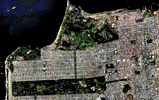| This Chapter's... |
introduction |
| Sustainability Plan / Food and Agriculture / Introduction |
|
San Francisco has a dramatic influence on regional agriculture. More than 5,000 food-related businesses purchase enormous quantities of fresh food to meet the demand of a discriminating clientele comprised of residents, regional day workers, and visitors. Significant institutional purchasing decisions about food are made at schools, grocery stores, city and non-profit shelters, the city jail, and so on. Using locally grown, organic food instead of shipping over long distances food grown with pesticides and chemical fertilizers will have a major impact on the country’s energy budget (the energy used to transport food), regional water quality and wildlife preservation, regional land use, and last (but not least) public health. San Francisco can make city policies that encourage sustainable agriculture, and private institutions and individuals can also make food-related choices that greatly influence many aspects of long-term sustainability. |

|
In addition to food purchases, there are local opportunities for greater food production. There is still a surprisingly large amount of vacant land, both public and private, that could be used even temporarily for food production. Rooftops of new and existing buildings offer a vast amount of potential agriculture space, if necessary structural modifications for food production purposes were made. Even San Francisco’s typically postage-stamp-sized back yards could be much more productive if residents increased fruit-tree planting and salad crop production. It will be necessary to re-think ideas of space, gardening techniques, and even growing mediums when it comes to food production in cities.
Access to nutritious food is another important
consideration. Significant numbers of San Franciscans, particularly those with low
incomes, lack food security. Their access to food which is nutritious, affordable,
safe and culturally responsive must be a principal goal of a plan for sustainability.
Food access can be improved through better systems of commercial food distribution,
better transportation for grocery shopping, more grocery delivery services, more
nutritious food in corner stores, more farmers’ markets, better utilization of federal
food programs, expanded opportunities for cooperative food purchasing, additional
community, school and household gardens, and by other means. Improved and increased
nutrition education, particularly in schools and senior centers, can contribute to
more healthy food choices. |
| top |
